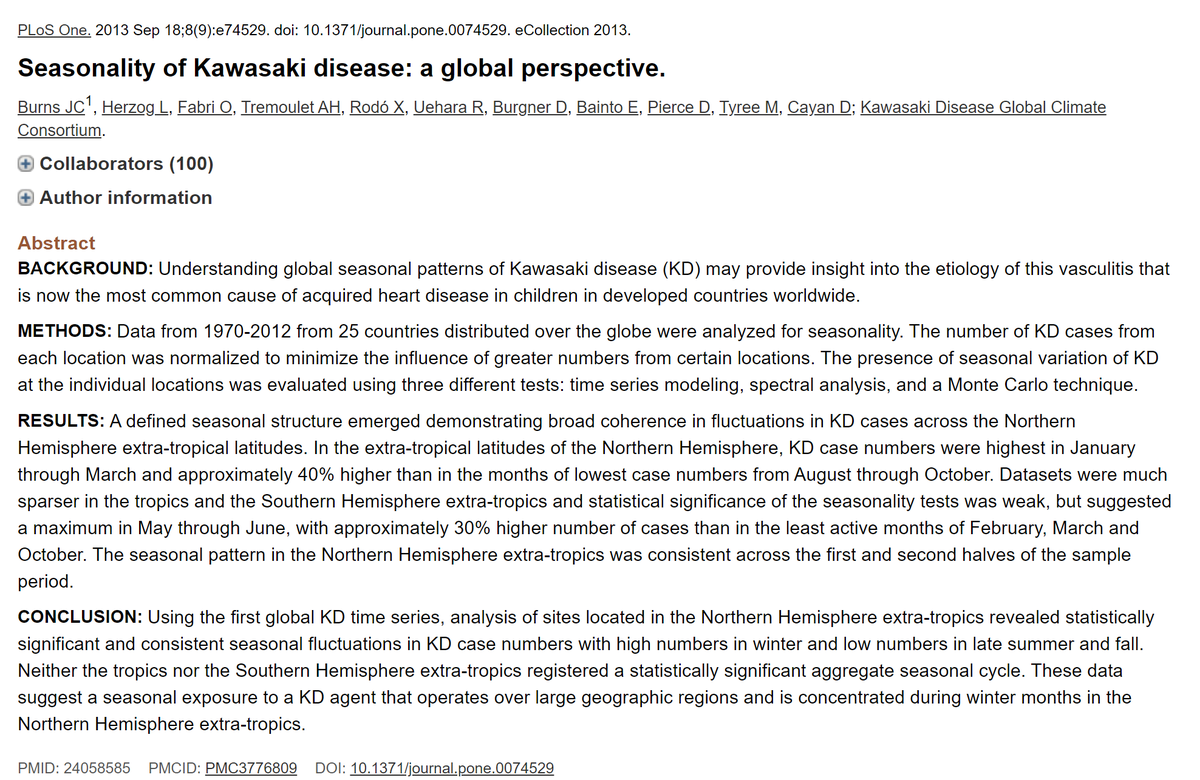this study is garbage and the lancet should be mortified to have published it
it& #39;s riddled w/ assumptive and mathematical errors so glaring i& #39;m honestly stunned
it makes both prevalence & simple arithmetic errors
how is this even possible in an allegedly peer reviewed journal? https://twitter.com/DrMattMcCarthy/status/1260746238242304001">https://twitter.com/DrMattMcC...
it& #39;s riddled w/ assumptive and mathematical errors so glaring i& #39;m honestly stunned
it makes both prevalence & simple arithmetic errors
how is this even possible in an allegedly peer reviewed journal? https://twitter.com/DrMattMcCarthy/status/1260746238242304001">https://twitter.com/DrMattMcC...
first, prevalence.
kawasaki disease is a seasonal disease. it presents in clusters, often at the end of winter beginning of spring.
so right here we have a MASSIVE problem.
they compare 2 months in 2020 to 50 prior months and extrapolate.
in a seasonal disease.
kawasaki disease is a seasonal disease. it presents in clusters, often at the end of winter beginning of spring.
so right here we have a MASSIVE problem.
they compare 2 months in 2020 to 50 prior months and extrapolate.
in a seasonal disease.
this is like looking at march and april to determine how often easter happens and then comparing it to a full year.
you& #39;d wind up thinking easter happens 6 times this yr vs 1 last.
so right there, the whole study which claims to be based on prevalence as "proof" is invalidated.
you& #39;d wind up thinking easter happens 6 times this yr vs 1 last.
so right there, the whole study which claims to be based on prevalence as "proof" is invalidated.
there is no actual cause, just a claim that a rise in prevalence is evidence of causality, itself a basic logical fallacy. (correlation = causality)
but as we can see, the prevalence is not measured properly so it& #39;s: "garbage in, garbage out."
but it gets worse.
but as we can see, the prevalence is not measured properly so it& #39;s: "garbage in, garbage out."
but it gets worse.
kawasaki also freq presents in clusters. so it& #39;s perfectly normal to see spikes
it& #39;s like measuring raindrops that land on your head and comparing one, rainy day to to a full year
again, it& #39;s just a completely invalid form of analysis, esp in a paper using prevalence as proof
it& #39;s like measuring raindrops that land on your head and comparing one, rainy day to to a full year
again, it& #39;s just a completely invalid form of analysis, esp in a paper using prevalence as proof
it gets worse.
nahas does a great job here of pointing out a basic mathematical error. they compared the figures for 2 months in 2020 with monthly figures prior
this literally doubled their rate
how can this possibly have gotten through peer review? https://twitter.com/NahasNewman/status/1261003685964009479?s=20">https://twitter.com/NahasNewm...
nahas does a great job here of pointing out a basic mathematical error. they compared the figures for 2 months in 2020 with monthly figures prior
this literally doubled their rate
how can this possibly have gotten through peer review? https://twitter.com/NahasNewman/status/1261003685964009479?s=20">https://twitter.com/NahasNewm...
they also double count some cases.
adjusting for both drops prevalence from reported 3.5% to 1.4%. https://twitter.com/NahasNewman/status/1261005208760565761?s=20">https://twitter.com/NahasNewm...
adjusting for both drops prevalence from reported 3.5% to 1.4%. https://twitter.com/NahasNewman/status/1261005208760565761?s=20">https://twitter.com/NahasNewm...
now consider seasonality. that could drop it from 1.4% to ~ 1%
(KW has 40% higher prevalence in jan-mar in the NH)
now add in clustering, something the paper never even tried to account for
it leaves this analysis in tatters and we STILL have not addressed the core fallacy
(KW has 40% higher prevalence in jan-mar in the NH)
now add in clustering, something the paper never even tried to account for
it leaves this analysis in tatters and we STILL have not addressed the core fallacy
the core fallacy is the assumption that correlation is causality.
they use an alleged (and inaccurate) rise in prevalence to presume that covid is the cause.
but there is zero evidence for this causal link.
this is outlandish.
they use an alleged (and inaccurate) rise in prevalence to presume that covid is the cause.
but there is zero evidence for this causal link.
this is outlandish.
it could well flow that other way: patients with kawasaki may be more prone to covid.
it could be that lockdowns from covid make kawaskai outbreaks more likely.
it could be 100 things.
it could be random.
nothing whatsoever in this grievously flawed analysis can help us know
it could be that lockdowns from covid make kawaskai outbreaks more likely.
it could be 100 things.
it could be random.
nothing whatsoever in this grievously flawed analysis can help us know
this is a stunning black eye for the lancet.
i& #39;ve seen them publish some bad work over the years, but i think this one takes the cake.
there is just no way this paper was peer reviewed by anyone remotely qualified and diligent.
these are basic math and logical errors.
i& #39;ve seen them publish some bad work over the years, but i think this one takes the cake.
there is just no way this paper was peer reviewed by anyone remotely qualified and diligent.
these are basic math and logical errors.
the "control group" is meaningless in a disease that hits in clusters, the comparison is peak season to full yr, and they literally made basic arithmetic errors.
the lancet should retract this paper and remove anyone who reviewed it from their peer review boards.
the lancet should retract this paper and remove anyone who reviewed it from their peer review boards.
this is hopelessly embarrassing and anyone using this paper to spread fear about "the kids" because of "science" will have a lot to answer for.
it& #39;s one of the worst papers i have ever seen published in a medical journal.
it& #39;s one of the worst papers i have ever seen published in a medical journal.

 Read on Twitter
Read on Twitter


